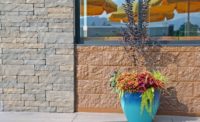I received a phone call from a longtime friend, and former co-worker of mine, Dave O’Neil. He had called to inquire about pop-outs over stucco and it is from our great conversation that I write this month’s article.
Somewhere in the ’70s and ’80s stucco buildings began to be designed with what us plasterers called “gingerbread,” those decorative embellishments on the stucco houses, apartments and office buildings. The designers threw them all in on the same elevation; quoins, window surrounds, belly bands and cornice details. The generic term for these embellishments was pop-outs, but plasterers referred to them as “stucco speed bumps.” This popular look is still in many of today’s building designs to varying degrees. In the beginning, most of these decorative features were framed out of wood and then covered with two layers of black paper, a metal lath and cornerbeads galore. As EIFS began to get popular, plasterers figured out that they could use EIFS technology for those decorative embellishments instead of wood.
Wood
When pop-outs were called for, the framers would simply use dimensional lumber to make them. They would surround the windows with 2x4s for example, or fasten a 2x4 over a 2x6 for a stepped pop-out. The “gingerbread” was made out of wood and like any wood product absorbed and moved with the environmental moisture.
Because the shapes were considered a decorative, non-structural feature, and because they would be covered by stucco, the quality of the wood was not a top priority. It then became a race to get the wood covered by the layers of WRB, and lathed, to keep the twist-and-turn dance from occurring.
Out here in the Southwest the wood would remain stable for a long period of time, sometimes forever, but in certain instances would twist and turn like an old 1960s dance. I even saw instances where this would occur after the three-coat stucco was applied. It would manifest itself as cracks along the corners and at the end-butts, and during seasonal rains would let the water enter through these cracks. Of course this led to further twisting and turning.
Some building/home owners would simply caulk these cracks which would stave off the inevitable for a few years or so. What was nice about using wood was that the lathers had a plethora of nailing area to fasten the trims and wire. It was easy to form the stucco wire around these shapes but one had to be careful not to tear or cut the WRB at the inside corners while they were forming the lath angles. For a lot of years this is how it was done.
Foam
Somewhere in time plasterers figured out that foam would be a better alternative to the wood used to create the architectural embellishments. The first generation process was to nail foam shapes onto the framing members and/or sheathing. At first the lathers tried wrapping the WRB over the foam shapes, taking care to fold, cut and bend the WRB to fit snug around all of the shapes. It was a nightmare, so the process then became to apply the WRB first, in a flat plane, then place the shapes over that. Then the lathers would apply the lath, taking care to bend the wire around the foam to maintain the desired form.
After the lath was applied to the wall and neatly folded around the shapes, corner bead trims were applied to the shapes (some contractors used expanded metal lath only for the shapes). Spiral shaft, metal cap fasteners were used to hold the corner beads in place, penetrating the foam, securing everything into the framing members. Where there were no locations to fasten into a framing member, the lather would wire tie into the lath layer.
This was the preferred method at the time and proved better than the wood embellishments. This new process took care of the cracking due to warping of the wood shapes. But, it was cumbersome, time consuming and the lathers had to have a number of differing lengths of fasteners, based on the foam shape thicknesses. Still, the cracking issues from twisting and turning were mitigated.
Foam II
The next generation of foam shapes over stucco came directly from the EIFS industry. We had started applying the acrylic EIFS finishes over stucco back in the early-’90s. The finish was easy to apply and stayed the same color through all of the seasons, didn’t change when wet and tended to span cracks better than the cement finishes of yore. It was a natural transition to then incorporate foam shapes, used in the EIF systems, right into the stucco cladding.
There fast became two popular methods to install these foam shapes. The first was to stick only the foam shape, allow it to set for 24 hours then cover it with base coat and mesh and lap the lamina onto the stucco surface adjacent to the shape. One big drawback to this method is when a fine finish was used the color would be different between the surrounding stucco and the lamina areas. (The golden rule of thumb in stucco is to have a uniform suction in the substrate to ensure color consistency no matter which type of finish you use). Many times this color variation was mitigated by spreading an acrylic modified base coat over the entire surface or by applying a color primer, both at an additional cost.
The second was to use a pre-coated shape. This method allowed the contractor to pre-mesh the shapes then send them to the jobsite for installation. Once installed the plasterers would simply patch in the joints, then apply the finish coat. There were no color variations since the lamina remained solely over the shape and didn’t lap into the stucco field. Pre-coated shapes are still a very popular method of adding pizzazz to the stucco façade, in fact there are pre-coated shape manufacturing companies that do nothing else.
One of the biggest considerations when using lamina coated shapes is that one cannot apply cement-based stucco finish over a conventional EIFS lamina, either it won’t initially stick or it may pop off over time. On EIFS basecoats used to encapsulate the foam shapes, only acrylic finishes can be used. There are some specialty coatings that are manufactured for application over foam (as a lamina) that can accept a cement finish. Check with the manufacturer of these products for recommendations and instructions.
Conclusion
So let’s go back to my discussion with Dave. We were sharing our experiences with shapes and stucco and I of course told him about using foam and lamina as the quickest and cleanest method of application. He stated that the project was going to use a cementitious finish and that the owner didn’t want any foam on his building. Dave had asked if there was an industry standard or code requirement for shapes on stucco. I dug deep into my resources and found there are none, with the exception of foam plastics which must comply with Chapter 26 of the IBC. There is also a tech bulletin at www.tsib.org that covers foam shapes and Portland cement/stucco.
I would like to end this article with a few points on pop-outs, points offered as best practice suggestions;
- Try not to use wood.
- When using foam and lath it is best to have the WRB in a flat plane under the shapes.
- Don’t fear the EIFS shapes (they’re not EIFS).
- Make sure the finish is compatible with the basecoat used to cover the shapes.
- Uniform suction makes for uniform color in your finishes.
- Always, always, always, slope the horizontal surface of the shape; away from the building of course.
Thank you, Dave!











